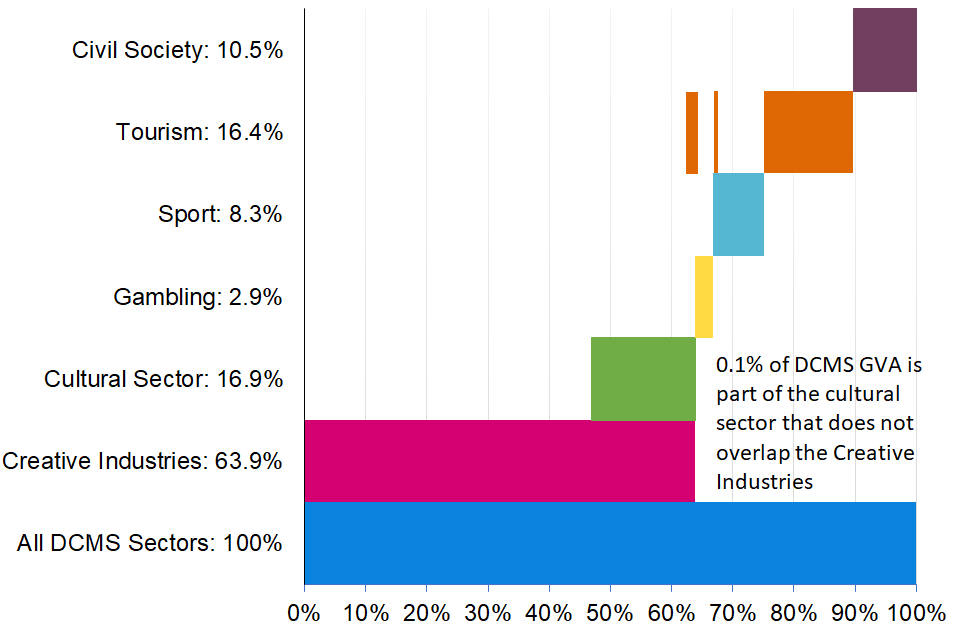Digital Sector Economic Estimates 2020: annual GVA
Updated 10 November 2023
Digital Sector Economic Estimates 2020: Gross Value Added
1. Introduction
Release date: 6 April 2023
Next release: Winter 2023/24
Geographic coverage: United Kingdom
Time coverage: 2010 to 2020
Responsible analyst: Rachel Moyce
This release provides estimates of the contribution of the Digital Sector to the UK economy from 2010 to 2020, measured by gross value added (GVA). The results for 2020 are affected by the coronavirus (COVID-19) pandemic.
We use current prices to report current sector estimates and chained volume measures for any comparisons over time.
A monthly GVA series with the Digital Sector and Telecoms separated out was published in February 2023, covering data from January 2019 to December 2022, at 2019 prices. This is more timely (two months lag) but less accurate than this series and can be used as a leading indicator.
2. Headline Findings
2.1 GVA in the Digital Sector
We use current prices to report current sector estimates and chained volume measures for any comparisons over time.
In 2020, the Digital Sector contributed £142.3 billion to the UK economy. This was 7.5% of total UK GVA, compared to 7.0% in 2019 (measured in current prices).
From 2010 to 2019 (the last full year prior to the pandemic) the Digital Sector grew by 66.6%, compared to 19.6% for the UK. The GVA of the Digital Sector then increased by 0.4% from 2019 to 2020, while the UK economy as a whole fell by 10.6%.

Figure 1: Index chart (2010=100), in chained volume measures (CVM) showing growth of Digital Sector compared to the UK economy, from 2010 to 2020.
The Department for Science, Innovation and Technology currently groups the Standard Industrial Classification (SIC) codes defining the Digital Sector into nine distinct subsectors, grouped by policy themes. Looking at these subsectors:
- The trend from 2019 to 2020 was affected by a fall of 9.9% in the “Film, TV, video, radio, music” subsector, counterbalanced by a rise in the “Telecommunications” (4.3%) and “Computer programming, consultancy and related activities” subsectors (2.3%).
- “Computer programming, consultancy and related activities” subsector (£53.4bn) is also consistently the largest in size within the Digital Sector, generating £53.4bn for the UK economy in 2020.
- The “Telecommunications” subsector (also a sector in its own right - Telecoms, see below) and the “Film, TV, video, radio, music” subsector are the next largest, generating £34.4bn and £18.9bn respectively.
These trends and findings are likely to reflect the impact of the restrictions imposed to control the spread of the coronavirus (COVID-19), from March 2020 onwards. The UK economy as a whole was adversely affected but the Digital Sector may particularly comprise industries that were less affected by its impacts, perhaps because they relied less on in-person production and/or consumption of goods and services.
2.2 GVA in Telecoms sector
Sector overlap
Telecoms is a sector definition that also sits entirely within the Digital Sector, and therefore its GVA does too. This chapter recognises that by providing more information on the Telecoms sector, building on the last chapter.
Sector findings
The Telecoms sector contributed £34.4 billion to the UK economy and made up 1.8% of total UK GVA (at current prices), compared to 1.7% in 2019. It is also four times larger in size than it was in 2010 (measured in chained volume measures).
The GVA of the Telecoms sector increased by 4.3% from 2019 to 2020, in real terms, meaning it was over four times larger in size in both 2020 and 2019 than it was in 2010. By contrast, the UK economy as a whole grew 19.6% from 2010 to 2019 and then fell 10.6% from 2019 to 2020, a year affected by the coronavirus (COVID-19) pandemic.
3. Further information
GVA is a measure of the increase in the value of the economy due to the production of goods and services. Its relationship to GDP is as follows:
GVA = GDP + Subsidies - Taxes
GVA is measured either at:
- current basic prices (‘nominal GVA’), which give the best ‘instantaneous’ measure of the value to the economy, but are not adjusted for the effect of inflation.
- chained volume measures (‘real terms GVA’), where the effect of inflation is removed.
The accompanying data tables consist of current prices and chained volume measures for the Digital Sector and Telecoms sector from 2010 to 2020, and a GVA index expressed in chained volume measures.
We use current prices to report current sector estimates and chained volume measures for any comparisons over time.
Methodological information on the sector definitions, data sources, derivation of GVA and limitations of the approach can now be found in the accompanying technical report, along with a summary of economic measures of these sectors that are published elsewhere.
The Economic Estimates: GVA (gross value added) for DCMS Sectors and the Digital Sector, 2020 are badged as National Statistics. This affirms that the statistics have met the requirements of the Code of Practice for Statistics.
The next update to these statistics will be released in winter 2023/2014, once the National Accounts have been published. The GVA figures in this report will all be revised in the next annual updates.
DCMS has developed a suite of economic estimates to understand the economic impact its sectors have on the UK economy. In combination with other economic indicators, GVA estimates help build a comprehensive picture of the UK economy, and of the DCMS Sectors’ importance within it.
The responsible statistician for this release is Rachel Moyce. For enquiries on this release, please email evidence@dcms.gov.uk.
For general enquiries contact:
Department for Science, Innovation & Technology
100 Parliament Street
London
SW1A 2BQ
For media enquiries contact: 020 7215 1000.
